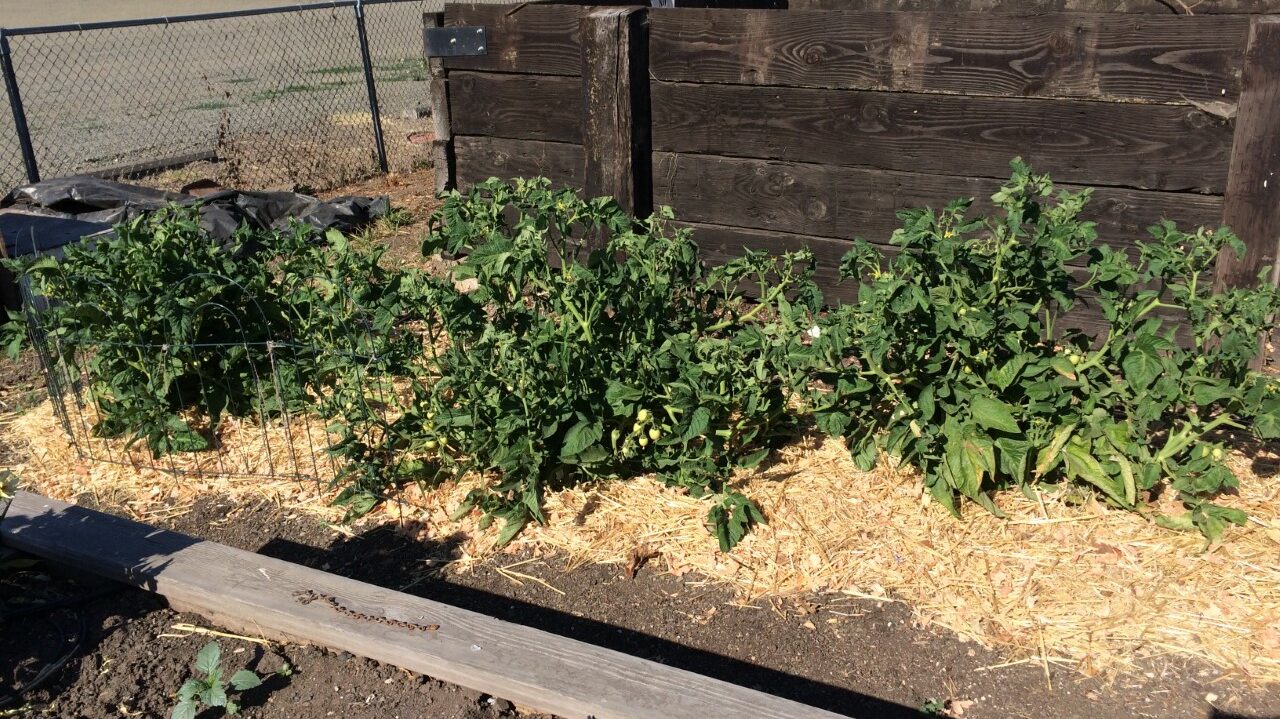How can you grow tomatoes and melons in a home garden with limited water?
By Ann B., Master Gardener Volunteer

OSU Extension, with Amy Garrett, has been developing the protocols and plants to garden without irrigation. Not only will this allow gardening in the ever-increasing years of drought, but it also can save on water bills. So, a project was started at the Master Gardener volunteer demonstration garden to determine whether vegetables can be grown in the home garden without watering.
First we used an auger to remove a soil core from our plot to determine if we had at least 4-6 feet of soil. Our soil was deep enough and contained clay as well. Organic-rich soils with some clay content have more water-holding capacity. Shallow or sandy soils are not amenable to dry farming. Before planting, the soil was tilled, some organic fertilizer and organic matter was added and the area was soaked. Plants were placed at least twice as far apart as usually indicated. We planted ours 6 feet apart. The soil was gently packed around the transplants and 2-3″ mulch was placed on top. During the summer we did not water at all, removed weeds regularly and did not walk on the area so that the soil was not compacted. Despite having a very warm summer (above 100F for a week), we harvested lovely Early Girl tomatoes. Subsequent years we harvested Dirty Girl tomatoes and melons.

During our first summer we noticed that one plant was much bigger than the other two. We had several theories of what caused it, from it getting less wind to being a hybrid planted by mistake. In the fall, at the end of the season, when we were removing the dead plants, we solved the mystery. This was a very clever plant. It grew a very long thick root that grew over about 6 ft. to a nearby bed that was watered. Therefore it was not really participating in the experiment! In subsequent years we did not irrigate that near-by bed.
Amy Garrett, OSU Extension Service, has run experiments on many other plants. These are some that she has determined do well with dry farming: Stupice and Perfect Rogue tomatoes, Beefy Resilient beans, Sweet Freckels melon, Eel River and Christmas watermelon, Zeppelin and Delicata winter squash, Dark Star and Costa Romanesco zucchini. And there are varieties of potato, dry beans, and grapes that will flourish. Although we did not do this, using a cover crop over winter, especially a legume such as crimson clover, will add organic matter and increase nitrogen availability.

Tips for success
- Don’t plant where there is competition for water from trees or other plants.
- Don’t plant on a slope.
- Raised beds are not ideal as they dry out faster; sunken beds work the best.
- Try to find a place protected from wind, which causes plants to lose water quicker.
- Use plants as indicators of where you have the most water. Notice which plants are still green and lush in August. They’re telling you where deep soil with water-holding capacity exists.
- Maintain a neutral pH of 6.5 to 7. Most soils in the Willamette Valley will need an application of lime.
- Timing is key. Plant when is not too wet or too dry. It’s tricky, but the important thing to remember is to plant when there’s still moisture in the top profile of soil.
- It’s possible to use little or no water and have a productive garden. It’s an important technique when you’re trying to save resources, and water is one of the biggest issues.
Resources
- OSU Extension- Small Farms Dry Farming Demonstration: http://smallfarms.oregonstate.edu/dry-farming-demonstration
- Runsten, D. and Mamen, K- Introduction to Dry Farming Organic Vegetables.
- CA Agricultural Water Stewardship Initiative 10 Nov 2014 http://agwaterstewards.org/index.php/practices/dry farming
- Solomon, Steve- “Gardening Without Irrigation: or without much anyway”, 2013
- Widtsoe, John-“The Better Days Books Origiganic Guide to Dry-Farming: A Complete System for Achieving Bountiful Harvests Where Rain is Scarce, and Without Irrigation”, Nov. 2008
- Widtsoe, John- “Dry Farming: A Guide for Farming Crops Without Irrigation in Climates with Low Rainfall and Drought”, 2018

